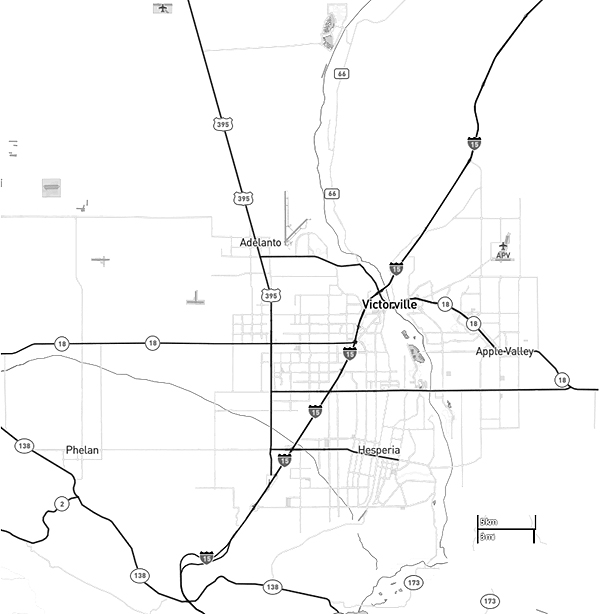--
Victor Valley

Victor Valley is a region located in the Mojave Desert in San Bernardino County, California. It is bordered by the San Bernardino Mountains to the south and the San Gabriel Mountains to the southwest. This area includes several communities, with the most notable being Victorville, Apple Valley, Hesperia, and Adelanto.
Here are some key aspects of Victor Valley:
Geography and Climate:
Situated in the High Desert, Victor Valley experiences a desert climate with hot summers and mild winters. The area is characterized by sparse vegetation typical of a desert environment.Economy:
Historically, the economy of Victor Valley was dominated by mining and agriculture. However, in recent decades, the area has diversified into retail, industrial, and service sectors. The presence of logistics centers due to the valley's strategic location along major transportation routes has also contributed to economic growth.Demographics:
The population of Victor Valley is diverse, with a significant portion of residents commuting to work in larger cities nearby, such as San Bernardino and Los Angeles.Transportation:
The Victor Valley is a significant transportation hub due to the intersection of major highways and railroads. Interstate 15, which runs through the valley, is a critical artery linking Southern California with Las Vegas and points north.Education and Culture:
The region is served by several school districts, providing education from elementary through high school. Victor Valley College offers higher education opportunities. The area is also home to cultural sites like the Victor Valley Museum, which showcases local history and natural history.Recreation:
There are numerous recreational opportunities in and around Victor Valley. The Mojave Narrows Regional Park offers activities like fishing, horseback riding, and hiking, exploiting the area's natural desert landscape.Victor Valley serves as an interesting blend of suburban and rural lifestyles, providing a quieter alternative to the bustling cities closer to the coast, while still maintaining accessibility to urban amenities.
Historical information
Victor Valley has a rich and varied history that reflects its changing roles in California's development. Here are some key historical points:Native American Heritage:
Before European settlement, the area was inhabited by Native American tribes such as the Vanyume (a branch of the Serrano) who lived along the Mojave River. These indigenous peoples utilized the river as a vital resource in the arid desert environment.Spanish and Mexican Era:
During the Spanish and later Mexican periods, the area was part of a larger land grant system. It was not heavily colonized during these times but was traversed by explorers and missionaries.American Settlement:
The area began to develop significantly with American settlement in the mid-19th century. Following the acquisition of California during the Mexican-American War, American settlers moved into the region.Railroads and Mining:
The discovery of gold and other minerals led to a boom in mining operations in the late 19th and early 20th centuries. The arrival of railroads, particularly the Santa Fe Railroad, further stimulated growth by connecting the region with broader markets and making transportation of goods feasible.Agricultural Development:
Agriculture became an important part of the local economy, with the arid land made fertile through irrigation projects. Cattle ranching and later fruit orchards and other crop cultivation characterized the area's agricultural scene.Post-World War II Growth:
Like much of Southern California, Victor Valley experienced a surge in population and economic growth following World War II. The development of the interstate highway system, particularly Interstate 15, made the valley more accessible and attractive for new residents and businesses.Modern Development:
In recent decades, the region has seen growth in the housing sector and the establishment of distribution and logistics centers due to its strategic location. This has transformed the economic landscape of Victor Valley from primarily agricultural and mining to include retail, industrial, and service sectors.Victor Valley's history is a testament to the adaptability and resilience of its communities in the face of environmental and economic challenges. The region continues to evolve, maintaining a balance between development and preserving the unique desert environment that defines it.
